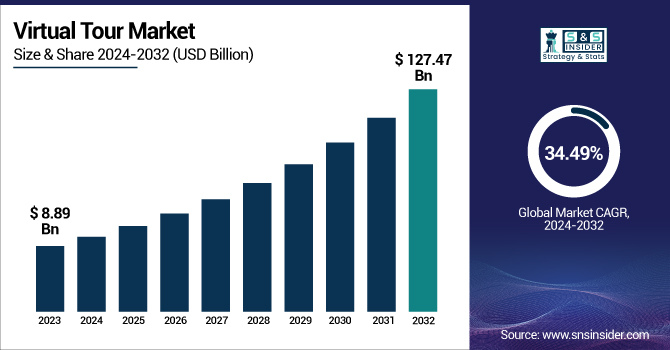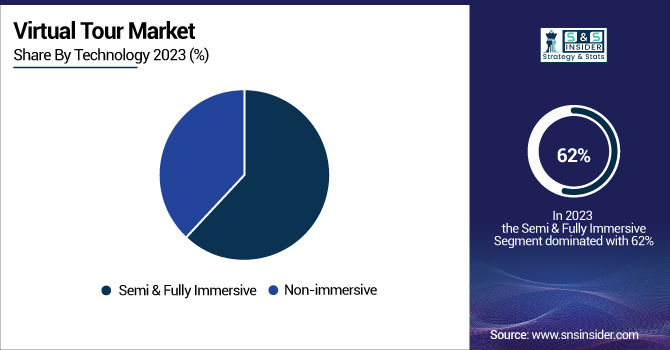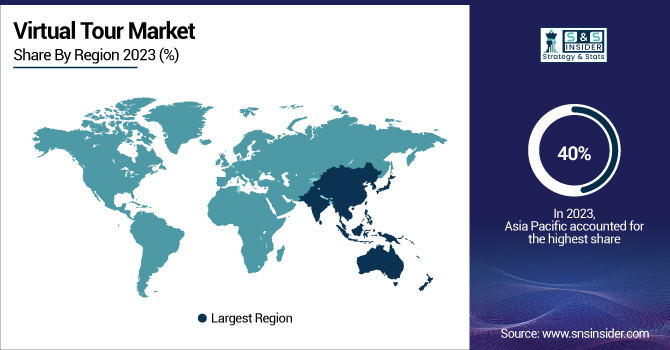Virtual Tour Market Report Scope & Overview:
The Virtual Tour Market was valued at USD 8.89 billion in 2023 and is expected to reach USD 127.47 billion by 2032, growing at a CAGR of 34.49% from 2024-2032.

To Get more information on Virtual Tour Market - Request Free Sample Report
This growth is due to rising investment patterns in immersive technologies, heightened consumer demand for interactive experiences, and the expanding need for digital tourism and real estate virtual walkthroughs. Consumer sentiment analysis points to a preference shift toward virtual experiences compared to traditional ones, particularly in industries such as tourism and real estate. Device usage statistics also reflect a spike in virtual tour interaction across smartphones, tablets, and VR headsets. The cost-effectiveness of virtual tours, providing a wider reach at low operational expenses, also propels market growth. Duration of engagement has also grown, with users becoming more engaged in virtual worlds.
U.S. Virtual Tour Market was valued at USD 2.18 billion in 2023 and is expected to reach USD 29.76 billion by 2032, growing at a CAGR of 33.7% from 2024-2032
The growth of the U.S. Virtual Tour Market is driven by higher demand for engaging experiences in tourism, real estate, and education. Technological advancements in VR and AR have made virtual tours more realistic and accessible, attracting businesses and consumers alike. The market is also supported by digital transformation across industries such as hospitality and retail. Virtual tours also provide cheaper advertising opportunities and lower transportation costs, making them even more attractive. Shifts in consumers' tastes for convenience, security, and interactive online experiences also drive increased adoption and use of virtual tours
Virtual Tour Market Dynamics
Drivers
-
Technological Advancements in VR, AR, and 360-Degree Video Drive Growth in the Virtual Tour Market
Increased adoption of VR, AR, and 360-degree video technologies has transformed the virtual tour experience, greatly enhancing realism and user interaction. Virtual reality (VR) enables users to be fully immersed in an interactive environment, while augmented reality (AR) adds digital overlays to real-world views, providing a smooth and dynamic experience. 360-degree video technology offers a complete view, giving users the impression that they are present at a location. These innovations are highly detailed, interactive, and customizable, which are essential to industries such as real estate, tourism, education, and retail. With continued advancements in technology, these virtual experiences become more realistic, and more consumer interest is generated, driving the market to new levels.
Restraints
-
Challenges such as High Costs, Limited Access, and Technical Issues Restrain Growth in the Virtual Tour Market
Developing and implementing high-quality VR, AR, and 360-degree video content requires huge investments in technology and equipment, which is a significant challenge for most businesses. Second, the unavailability of requisite devices like VR headsets or high-speed internet connections restricts the market to a wider audience. The second is the restricted quantity of quality, full-fledged content for various industries, limiting the range of virtual tour experiences. Technical constraints, like motion sickness, poor image quality, and restricted interactivity, may impact satisfaction levels and limit interaction. Issues regarding privacy and security of data also crop up when users access virtual environments. Finally, some customers are loath to adopt virtual tours in favor of more traditional, physical-based ones.
Opportunities
-
Virtual Tour Market Growth Driven by E-Commerce Integration, Tourism, Real Estate, Education, and Personalized Experiences
Virtual try-ons and 360-degree product views are revolutionizing e-commerce by offering interactive shopping experiences that lead to better purchasing decisions by consumers. The tourism industry is also gaining as virtual tours present a new means through which individuals can visit places virtually, particularly when traveling is restricted. Real estate companies can access international markets with virtual property tours, expanding their potential market. For education, virtual field trips and interactive learning scenarios provide new mechanisms for engaging learners. Moreover, improvements in AR/VR equipment make virtual tours more affordable, while companies may utilize virtual space for remote meetings and team building. As personalized experience demand increases, the virtual tour industry is set to grow in various industries.
Challenges
-
User Experience Issues like Motion Sickness, Glitches, and Poor Resolution Hinder Growth in the Virtual Tour Market
Motion sickness, system glitches, and low image resolution can seriously detract from the immersive experience virtual tours are meant to provide. Users who feel uncomfortable as a result of motion sickness can become unable to effectively participate in the tour, making it less effective. Technical difficulties like slow loading times or malfunctioning during interactive sessions can cause irritation and prevent further usage. Also, poor-quality visuals or insufficiency in detail within some of the virtual tours can take away from the sense of realism and participation, creating a less enjoyable user experience. Consequently, enhancing the quality of virtual experiences so that interactions are smooth, comfortable, and visually stunning is essential for the market's long-term viability and retention of users. Resolving these user experience challenges is important in order to gain a wider user base.
Virtual Tour Market Segment Analysis
By Technology
The semi and fully immersive segments led the Virtual Tour Market with the largest revenue percentage of around 62% in 2023. The reason for their dominance lies in the rising consumer interest in highly interactive and engaging experiences. VR and AR are technologies that provide an immersive, realistic experience that finds its application in areas ranging from real estate to tourism and education. These immersive technologies provide users with a more engaging, lifelike exploration, which enhances the overall value and popularity of virtual tours.
The non-immersive segment is anticipated to expand at the fastest CAGR of approximately 36.35% between 2024-2032. This expansion is fueled by the growing use of more affordable, cost-effective options such as 360-degree video tours and web-based interactive experiences. Non-immersive virtual tours enable a wider audience to enjoy virtual tours without the use of dedicated devices such as VR headsets. Their accessibility makes non-immersive tours highly sought by businesses looking to offer cost-efficient means of engaging consumers.

By Application
The real estate segment dominated the Virtual Tour Market with the highest revenue share of about 37% in 2023. This is due to the increasing adoption of virtual tours for property showcasing, which allows potential buyers or renters to explore properties remotely, saving time and resources. Virtual tours offer a detailed, immersive experience, providing potential buyers with a realistic sense of space and layout, making it easier to make informed decisions, thereby driving the segment's growth.
The tourism and hospitality segment is expected to grow at the fastest CAGR of about 36.44% from 2024-2032. This growth is fueled by the rising demand for virtual tourism experiences, allowing travelers to explore destinations remotely. With the advent of immersive technologies, virtual tours can provide an interactive and accessible way to visit famous landmarks, museums, and hotels, particularly for individuals unable to travel. This trend is reshaping the travel and hospitality industry.
By Component
The hardware segment dominated the Virtual Tour Market with the highest revenue share of about 47% in 2023. This dominance is primarily driven by the widespread use of advanced devices such as VR headsets, AR glasses, and 360-degree cameras. These hardware technologies are essential for delivering fully immersive experiences in virtual tours, making them popular across sectors like real estate, education, and tourism. As the demand for more realistic and interactive experiences grows, the hardware segment continues to lead the market.
The services segment is expected to grow at the fastest CAGR of about 37.49% from 2024-2032. This growth is driven by the increasing need for custom virtual tour development, content creation, and platform integration services. As businesses across various industries seek to implement and optimize virtual tour solutions, there is a growing demand for professional services that ensure high-quality experiences. These services support innovation, customization, and the scalability of virtual tours.
Regional Analysis
Asia Pacific dominated the Virtual Tour Market with the highest revenue share of about 40% in 2023. This dominance is driven by the rapid adoption of advanced technologies such as VR, AR, and 360-degree video, particularly in countries like China, Japan, and India. The region's growing real estate, tourism, and retail sectors leverage virtual tours for immersive consumer experiences. Additionally, a tech-savvy population and increased investments in digital infrastructure contribute significantly to the market's growth in the Asia Pacific.
North America is expected to grow at the fastest CAGR of about 36.66% from 2024-2032. This growth is fueled by the strong presence of key players, innovation in VR/AR technologies, and increasing demand for virtual experiences across industries like real estate, tourism, and education. The region’s advanced infrastructure, high disposable income, and early adoption of emerging technologies are key drivers behind the rapid expansion of the virtual tour market in North America.

Get Customized Report as per Your Business Requirement - Enquiry Now
Key Players
-
Matterport Inc. (Matterport Pro 2, Matterport Cloud)
-
Kuula LLC (Kuula Pro, Kuula Editor)
-
RTV, Inc. (RTV Virtual Tours, RTV Hosting)
-
Concept3D, Inc. (3D Tours, Virtual Campus Tours)
-
Roundme Limited (Roundme Virtual Tours, Roundme Pro)
-
Invision Studio, Inc. (Invision 360 Studio, Invision Virtual Tours)
-
Eye Revolution Ltd. (Eye Revolution VR, Eye Revolution Tour Creator)
-
TourVista (TourVista Virtual Tours, TourVista Pro)
-
CloudPano (CloudPano 360 Virtual Tour, CloudPano White Label)
-
Eyespy360 (Eyespy360 Virtual Tours, Eyespy360 360 Camera)
-
Blue Raven Studios (Blue Raven Virtual Tours, Blue Raven Hosting)
-
Exsight 360 (Exsight Virtual Tour, Exsight 360 Pro)
-
Pan 3Sixty (Pan 3Sixty Virtual Tour, Pan 3Sixty Pro)
-
360 Imagery (360 Imagery Tours, 360 Imagery Hosting)
-
MI 360 (MI 360 Virtual Tours, MI 360 Hosting)
-
Starts360 (Starts360 Pro, Starts360 Virtual Tours)
-
360 Pano VR Solutions Private Limited (360 Pano VR Tour, 360 Pano VR Viewer)
-
TourWizard (TourWizard Virtual Tours, TourWizard Pro)
-
The Ricoh Company (Ricoh Theta Z1, Ricoh Theta SC2)
-
Klapty (Klapty Virtual Tours, Klapty Pro)
-
3DVista (3DVista Virtual Tour, 3DVista Tour Editor)
Recent Developments:
-
In 2024, Kuula partnered with Ricoh to offer exclusive discounts on the Ricoh Theta Z1 and Theta X cameras. This collaboration aims to enhance virtual tour creation with high-quality, easy-to-use equipment.
-
In 2025, Costar Group completed its acquisition of Matterport, enhancing 3D technology for real estate and offering innovative virtual tour solutions to transform property marketing and data analytics.
| Report Attributes | Details |
|---|---|
| Market Size in 2023 | USD 8.89 Billion |
| Market Size by 2032 | USD 127.47 Billion |
| CAGR | CAGR of 34.49% From 2024 to 2032 |
| Base Year | 2023 |
| Forecast Period | 2024-2032 |
| Historical Data | 2020-2022 |
| Report Scope & Coverage | Market Size, Segments Analysis, Competitive Landscape, Regional Analysis, DROC & SWOT Analysis, Forecast Outlook |
| Key Segments | • By Component (Hardware, Software, Services) • By Technology (Non-immersive, Semi & Fully Immersive) • By Application (Real Estate, Tourism & Hospitality, Art Galleries and Museums, Others) |
| Regional Analysis/Coverage | North America (US, Canada, Mexico), Europe (Eastern Europe [Poland, Romania, Hungary, Turkey, Rest of Eastern Europe] Western Europe] Germany, France, UK, Italy, Spain, Netherlands, Switzerland, Austria, Rest of Western Europe]), Asia Pacific (China, India, Japan, South Korea, Vietnam, Singapore, Australia, Rest of Asia Pacific), Middle East & Africa (Middle East [UAE, Egypt, Saudi Arabia, Qatar, Rest of Middle East], Africa [Nigeria, South Africa, Rest of Africa], Latin America (Brazil, Argentina, Colombia, Rest of Latin America) |
| Company Profiles | Matterport Inc., Kuula LLC, RTV, Inc., Concept3D, Inc., Roundme Limited, Invision Studio, Inc., Eye Revolution Ltd., TourVista, CloudPano, Eyespy360, Blue Raven Studios, Exsight 360, Pan 3Sixty, 360 Imagery, MI 360, Starts360, 360 Pano VR Solutions Private Limited, TourWizard, The Ricoh Company, Klapty, 3DVista |

